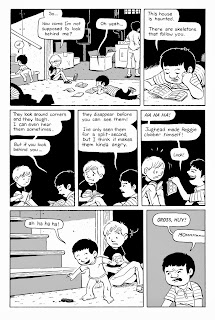Dakota McFadzean came into CCS as an already fully-formed talent, but it's clear that his experience there only served to bolster his confidence and encourage him to take even more chances as a creator. In his first collection of short stories, Other Stories and the Horse You Rode In On, McFadzean manages to create a surprisingly coherent meta-narrative. McFadzean is not unlike Joseph Lambert in that many of his stories have to do with the ways in which children engage the world in magical realist terms, but there's a certain melancholy that pervades his work in ways that it doesn't for Lambert. A big part of that is McFadzean's work is marked by its sense of restraint and subtlety, even in the craziest of situations.
For example, the opening story "Standing Water" is about a kid navigating a world that's frozen in time, as though he were the only one who could travel through a world that's entirely underwater. Friends, family and pets float limply in the water, and his attempts at interacting with the world reveal a hidden well of meanings that have lost all their significance in the wake of what is essentially the end of the world. What seem to be acts of revenge or cruelty lose their meaning, leading him to a sense of sad resignation in a totally absurd situation. There's no background or explanation given here, because the emotional resonance of this world is what's important.
The same is true in "Unkindness", which is one of McFadzean's very best stories. It's typical of his work in that it depicts small town life in Canada in an entirely unromanticized fashion and also contains unexplained elements of magical realism. While there's a strong streak of naturalism running through his work (the world he creates feels quite solid and real), his character design here is looser and more expressive. He allows for a certain rubbery quality of reality that gives him the opportunity to mold and bend it. An "unkindness" is what is referred to as a gathering of ravens, and there is indeed a mysterious and surprising visitation by the birds in the dead of winter. The birds observe, feed and even communicate (one says "goodbye" to a little boy), often by creating a series of mysterious lines and circles in the snow. The title also refers to small acts of unkindness in the story, leading up to a mother essentially telling her teenage daughter that she was a mistake. There's a sureness to the way in which McFadzean flips from character to character in this story, each of whom are just trying their best to get by in life without a whole lot of happiness or fulfillment. When one character tells another "I'm going home to run out the damn clock like I do every damn day", it's a brutal statement of how life is that comes after a joke that covers up that fact. There's also a sort of hidden momentum and tension in this story generated by the wild card factor of the birds and the repressed emotions that well up as the story unfolds, exploding in a manner that is unexpected. It's also a story about different entities being at cross-purposes and being unable or unwilling to fully communicate their desires. That's made literal in the mystery of the ravens--there's no real sense of what their purpose is or if they mean harm to the humans in the town, but it's also expressed in the way that characters talk past each other. McFadzean never spells out the secrets and mysteries in his stories, preferring that they hold a charge for the reader to interpret as they see fit.
One running theme in the book is that of loss or the sense that something is about to end. That's true in "Boxes" (about a young woman leaving a town and the people she sees on the bus behind) and "Skeletons" (about a boy telling his best friend he's going to move). The former story concerns the boxes we put other people in as we classify them, the ways in which others see us that we don't understand, and the ways in which categories in general limit us. The latter involves a supernatural element, as the titular skeletons refer to what happens when we look back. If that seems like a heavy-handed metaphor, it's mitigated by the way in which McFadzean uncannily is able to get at the ways in which kids actually behave toward each other as well as the genuinely spooky nature of his imagery. "Seelie Court" is a different take on this kind of relationship, where two friends share their difficulties as young adults in a context of wishing magic was true. While McFadzean offers a visual hint regarding this magic, the real power here is in the way the two boys are able to talk to and relate to each other in an honest manner, while still retaining the profane, slightly distancing tactics that boys have with regard to their feelings.
Another story about loss and memory is "Ghost Rabbit". This story features the parallel narrative of a young girl growing up in a house where her mother struggles with her own mentally decaying mother along with an anthropomorphic rabbit haunted by the titular ghost rabbit. The lingering images of memory loom large in this story and they're elegantly portrayed by McFadzean. McFadzean implies that the anthropomorphic rabbit's narrative is a product of the girl's imagination as she processes the repeated phone conversations her mother has with her grandmother, until she actually sees a rabbit in the wild. Initially, that real-life meeting leads to a joyous fantasy sequence (featuring two pages of the characters dancing with each other excitedly in a manner not unlike that of Charles Schulz or Bill Watterson characters) but the ghost lingers further when she understands that the rabbit is sick and soon dies. We see that small ghost hop after her when she comes inside after covering the dead rabbit with leaves, as the girl has acquired the same sort of ghost that she imagines her mother is burdened with. This is a simple, elegant and poetic story.
McFadzean also seems to be fascinated by the human capacity for cruelty. "Everything You Can Think Of Is True" is about a child who can literally think a weird, child's version of anything he wants into existence--only he's being held by scientists for experiments. McFadzean's primitive line used for the things the child imagines is almost heartbreaking in its execution, especially when the child literally disappears into his fantasies. "Brokenface" is another more fanciful tale involving a man without a face and the assorted cartoonish indignities he suffers as a result; the story has the rhythm of a Milt Gross strip, even as it grows weirder and more contemplative by its conclusion. "Snotgurgle" transfers McFadzean's interest in the real lives of fantastic creatures like gnomes into a nightmarish torture scenario, one whose seemingly happy ending is a cruel fake-out of its own. "And The Horse You Rode In On" is an Archie pastiche that features extended segments about a lone horseman riding out on the prairies by himself, relishing his solitude. This is the daydream of a nebbish who is manipulated, abused and/or ignorde by school administrators, fellow students and his parents. He has a laughable lack of agency even as he's drawn to fit in a kind of Archie-verse, content to flit from embarrassment to embarrassment even as he refuses to truly knuckle under to anyone else's desires. There's a delicious, unresolved tension at the end of the story where the protagonist is given a chance to renounce his "purity" once and for all with a bag of weed that was given to him, but it's unclear what path he will choose.
The oddest story in the book is "Leave Luck To Heaven". It's about a young man visiting a slightly older person to have a "session" playing a video game. The structure of the session is more like Lacanian psychotherapy, wherein the analyst is often cold and demanding, threatening to throw out the analysand if they detect inauthentic action or speech. This has the rhythm of therapy, with the interesting detail that the reader can't see the eyes of either character. The corpulent, slovenly and highly erudite analyst has long hair that obscures his eyes, while the analysand is wearing glasses that deflect the reader's gaze. This device prevents the reader from getting a clear idea of either character's motives, forcing one to rely entirely on body language and what is actually said. The story also features the only color portion of the book, which plays out in a Chris Ware-style diagram that's also a sort of circuitry sketch. The story sums up McFadzean's work in a nutshell: subtle, bizarre, restrained, probing, melancholy, hopeful and mysterious. Like the analyst, McFadzean has no interest in giving readers pat answers to the scenarios he introduces. Instead, he wants readers to experience the isolation, loneliness, tenderness, familiarity and strangeness of the environments he creates and the people he introduces. Thanks to his skill as a draftsman, storyteller and writer of dialogue, each and every story is a success, and each story builds on the momentum of the next.
Saturday, November 30, 2013
Subscribe to:
Post Comments (Atom)










I picked up Other Stories and the Horse You Rode in On a couple weeks ago. I poured through it on first reading and have since tackled it a second time, soaking up every frame.
ReplyDeleteThis is definitely a book I'll be gifting to a couple discerning friends this year. McFadzean impresses for sure.